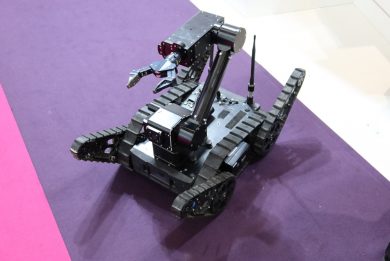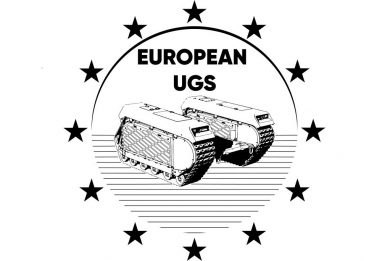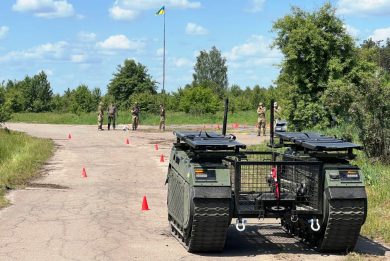Milrem Robotics: looking forward to armed UGVs with iMUGS 2
The integrated Modular Unmanned Ground System (iMUGS) has been one of the European Union’s largest defence UGV development projects.
Following the success of what has now become iMUGS 1, the Consortium led by Milrem Robotics has now enlarged, and responded to the European Defence Fund’s (EDF) call to develop next-generation Multipurpose Unmanned Ground Systems (UGS). Known as the iMUGS2 project, it will take over from iMUGS1 to further develop UGVs technologies and concepts, unmanned ground systems picking up pace considering lessons identified and lessons learned on the Ukrainian battlefield. EDR On-Line talked to Raul Rikk, the Capability Development Director at Milrem Robotics, who is in charge of all Milrem European projects
According to iMUGS consortium documents, the iMUGS2 project aims to develop an unmanned ground system capable of manned-unmanned and unmanned-unmanned teaming with other robotic unmanned platforms and manned infantry vehicles to provide them full battlefield support.
“Thanks to the success of iMUGS1, the iMUGS2 team is much wider than its predecessor. In iMUGS1 we had 15 industry partners from seven countries, now we have 29 industry partners from 15 countries,” Raul Rikk says.
The iMUGS 2 project will aim at facilitating the development of a standardized open architecture, ensuring interoperability and seamless integration of defence solutions among member states. Leveraging cutting-edge European technology and expertise in combination with the utilization of other ongoing EU projects, iMUGS2 will strengthen the European defence industrial base, enhancing strategic autonomy and reducing dependency on non-European technologies.
While enhancing the defence capabilities of individual member states and contributing to the collective security of the European Union, iMUGS2 will focus on the practical implementation of mature, ready-to-deploy solutions that are easy to procure and tailored to each member state’s specific needs.
“The iMUGS 2 project is a very logical continuation from iMUGS1 that was completed in 2023; the role of the latter was more or less to develop the unmanned technology and demonstrate how this could be used in non-lethal applications. At that time, talking about weapons on unmanned platforms was almost a taboo,” Mr. Rikk, a former military officer in the Estonian Defence Forces, states.
“What is exactly the operational context? How can these unmanned systems support dismounted troops? This is the first goal of iMUGS2, we want to take the results of iMUGS1 and develop them further so that those systems become real combat cost-effective systems.”
During most of the iMUGS1 project timeframe no direct confrontation was ongoing in Europe, and Step 2 of iMUGS was supposed to deal mostly with distributed logistic something that remains a key issue in the light of the Ukrainian conflict, however the events of February 24th, 2022, dramatically changed the existing situation. “I think that Europe has overcome the weaponisation issue because of the war in Ukraine. On the other hand, we see that Russia is developing its unmanned capability at full speed. They have about 300 different educational and scientific institutions all dealing in a way or another with unmanned systems development, and eight out of these 300 are specifically focused on unmanned ground systems. At the moment, Russia has already developed more than 40 different UGSs applications and they are heavily testing all that in Ukraine. They don’t have any kind of limitations, they put all sorts of weapons on unmanned systems, they try to use whatever is lethal. So, if Europe really wants to face this kind of capability, we certainly need to put weapons systems on our UGVs,” Mr. Rikk clearly states, adding that of course in Western Europe the man-in-the-loop will remain.
“Logistics will still play a huge part in military operations, that’s true. But on the other side, we need weapons systems on UGSs, because the future will see robotic systems against robotic systems. And the winner will be the one who has the better system and who can respond quicker. This is one of the three goals we have in iMUGS2. The first is to develop the architecture further, so it’s going to be like a plug and play system with different payloads. The second goal is to develop the combat ready infantry support system so that the infantry can clearly take it and start to use it. And the third goal is aiming even further, trying to conceptualise how unmanned systems could be used at battalion level,” Mr Rikk explains.
“At the moment, with iMUGS2, we cannot reach that because both budget and time do not allow it. But we try to conceptualise how this unmanned battalion would look like in the future,” he said, letting us understand that this will be left for the next iteration, iMUGS3, the battalion concept aiming de facto to an unmanned all arms task group. “We have most of the technologies already available, we just need to put this technology into practice to serve our military capability. This also shows the way on how this technology should be developed further. We have many different development programmes in Europe under the European Defence Fund and under the European Defence Agency, but they don’t have such an operational context. They are developed as technologies, too separately, and what we need is a common target, so let’s try to create this unmanned battalion,” Mr. Rikk added, underlining the need to reduce discrepancy between technology and military applications, something that would also help industry to better understand in which direction it should develop technology.
At which point are we with iMUGS2? The EDF-2024-DA-GROUND-UGS-STEP call is part of the EDF 2024 call, and a decision should be taken around May 2025.
“There is a bit more that one month to go, and after that we will know if we can continue or not. At the moment, we don’t get a strategic direction from the European Union, and we also don’t get it from NATO. I don’t think that there is an agreed path on how NATO countries will move forward with land robotics. There are concepts for air robotics as well as for maritime robotics, but none in the land domain. The only known paper that exists is the European Defence Agency autonomous systems action plan (APAS), which defines the path for the next 15 years. This is the concept we can rely on and it includes weaponised systems,” the Milrem representative said.
With Russia and China, as well as the United States, rapidly developing new systems, how should Europe behave? Single European nations defence needs are orders of magnitude smaller than those of the above-mentioned countries, thus the need to cooperate and to standardise in order to make things interchangeable and interoperable. However, this inevitably slows down the development and innovation process. “I think we need first innovation, and secondly we need to standardise,” Mr. Rikk states. “While we are doing standardisation, Russians, Chinese and Americans, are developing and innovating rapidly, and we are just losing the game this way.” How does this fits with the iMUGS2 process? “I think that while we do iMUGS2, we innovate during the process and then we standardise certain aspects. For example, we create the interfaces to allow us to put payloads on top of the vehicle,” easier for mechanical and electric interfaces than for digital ones. Not to speak about standardising legal issues linked to the use of weapons on unmanned platforms, something that makes a difference between the logistic use of UGVs and the combat use. But if Europe wants to remain relevant in the UGV field, that ultimately might become the main players on future battlefields, it should probably be good to follow what Raul Rikk says.
Photos courtesy Bittium, LMT, Milrem Robotics and P. Valpolini









